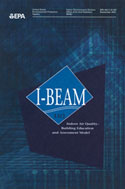IAQ in Large Buildings
Indoor air quality (IAQ) problems are not limited to homes. In fact, many office buildings have significant air pollution sources. Some of these buildings may be inadequately ventilated. For example, mechanical ventilation systems may not be designed or operated to provide adequate amounts of outdoor air. Finally, people generally have less control over the indoor environment in their offices than they do in their homes. As a result, there has been an increase in the incidence of reported health problems.
Resources
EPA's Green Building Portal
This site is a gateway to many different EPA programs to improve the environmental impacts of building and development. These include Energy Star, Water Efficiency, Environmentally Preferable Purchasing, and more.
Green Indoor Environments Program
Do your buildings create a healthy environment for their occupants? The building industry is increasingly focused on making its buildings greener, which includes using healthier, less polluting and more resource-efficient practices. Indoor environmental quality (IEQ) refers to the quality of the air and environment inside buildings, based on pollutant concentrations and conditions that can affect the health, comfort and performance of occupants -- including temperature, relative humidity, light, sound and other factors. Good IEQ is an essential component of any building, especially a green building.
IAQ Scientific Findings Resource Bank

An IAQ Scientific Findings Resource Bank is being developed by the Lawrence Berkeley National Laboratory with funding support from EPA provided through an interagency agreement. It is a resource for public health professionals, building professionals, and others who seek scientific information about the effects of IAQ on people’s health or work performance. The IAQ Scientific Findings Resource Bank provides information summarizing the state of scientific knowledge about the relationships between people’s health and productivity and the IAQ conditions or associated building characteristics in which the people work or reside. This web site also provides links for downloading published journal articles that were developed under the project.
- Learn more: www.iaqscience.lbl.gov
Resources/Publications
- IAQ Building Education and Assessment Model (I-BEAM)
- Building Assessment, Survey and Evaluation Study (BASE)
- Energy Cost and IAQ Performance of Ventilation Systems and Controls Modeling Study
- Building Air Quality: A Guide for Building Owners and Facility Managers
- Building Air Quality Action Plan
 |
IAQ
Building Education and Assessment Model
(I-BEAM) The Indoor Air Quality Building Education and Assessment Model (I-BEAM) is a guidance tool designed for use by building
professionals and others interested in indoor air quality in commercial buildings. I-BEAM updates and expands EPA's Building Air Quality guidance and
is designed to be a comprehensive state-of-the-art guidance for managing IAQ in commercial buildings. I-BEAM contains text, animation/visual, and
interactive/calculation components that can be used to perform a number of diverse tasks.
|
| Building Assessment, Survey and Evaluation Study (BASE) To gain a better understanding of indoor air quality (IAQ), EPA's Office of Radiation and Indoor Air conducted a major study of IAQ in public and commercial office
buildings. This study, the Building Assessment, Survey and Evaluation (BASE) study, was a cross-sectional study of 100 randomly selected office buildings. The BASE raw dataset will be most useful for researchers, scientists, building professionals, public health officials and policy makers working on indoor environments. Using it will require familiarity in working with a complex dataset characterizing public and commercial office buildings in the U.S. with respect to IAQ and occupant perceptions. The dataset allows examination of possible relationships among building and HVAC features, pollutant concentrations, and occupant symptoms and perceptions. In addition, the data allow for hypotheses development regarding these relationships. |
|
| Energy Cost and IAQ Performance of Ventilation Systems and Controls Modeling
Study In 1999, EPA completed an extensive modeling study to assess the compatibilities and trade-offs between energy, indoor air quality, and thermal comfort objectives for HVAC systems, and to help formulate strategies to simultaneously achieve superior performance on each objective. Variations of Constant Volume (CV) and Variable Air Volume (VAV) HVAC systems were modeled in three different climates-hot and humid (Miami), temperate (Washington D.C.), and cold (Minneapolis). Buildings included several variations of an office building, plus a school, and an auditorium. |
|
| Additional Resources | |
 |
Building Air Quality: A Guide for Building Owners and Facility Managers The text of Building Air Quality is available here as a series of PDF files which you can download and view or print. You can go to the table of contents and select just the form or section that you need to download and view/print, or you can download the entire PDF version of the guide as a ZIPPED file to view/print. This guidance is only available in PDF.
|
 |
Building Air Quality Action Plan The Building Air Quality Action Plan (BAQ Action Plan) meets the needs of building owners and managers who want an easy-to-understand path for taking their building from current conditions and practices to the successful institutionalization of good IAQ management practices. It emphasizes changing how you operate and maintain your building, not increasing the amount of work or cost of maintaining your building. The BAQ Action Plan follows 8 logical steps and includes a 100-item Checklist that is designed to help verify implementation of the Action Plan. This guidance is only available in PDF.
|
![[logo] US EPA](https://webarchive.library.unt.edu/eot2008/20080921083436im_/http://www.epa.gov/epafiles/images/logo_epaseal.gif)

